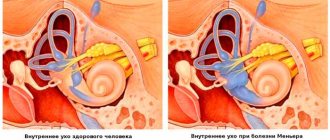- Published by: Laima Jansons
Complaints of headache occur in almost any pathology and can vary depending on the location and nature of the manifestation (burning, pressing, cutting, pulsating, etc.), duration, causes and many other parameters. Burning pain in the head most often develops due to cardiovascular or neurological pathology , less often the state of the endocrine system plays a role.
Photo 1. Headache cannot be ignored. Source: Flickr (C. Michael's Photography)
Causes of a burning sensation in the head
Burning pains often occur for various reasons; oddly enough, they have nothing to do with the head itself, but are most often caused by problems that are located in completely different areas, for example, with the spine or the cardiovascular system. The endocrine system also often lets you know about problems through burning pain localized in the head.
Cervical osteochondrosis
With osteochondrosis, pain can occur as a result of two parallel developing processes:
- Compression of the spinal nerves;
- Partial compression of the vertebral artery.
In sum, these two factors lead to disruption of blood supply and innervation, which is felt as burning, pressing pain . Most often they are diffuse in nature and spread over the occipital, temporal, and parietal regions.
Arterial hypertension
Hypertension and its complications are the most common disease among people over 40 years of age. For several decades, it has been a leading cause of death worldwide.
When pressure increases, especially during a hypertensive crisis, one of the main symptoms is tinnitus, pulsation and burning pain in the temporal, occipital, parietal, and frontal regions. Also, high blood pressure may be accompanied by a feeling of midges in front of the eyes, dizziness, nausea, vomiting, and loss of consciousness. Such conditions require immediate help , since they can provoke the development of a heart attack or stroke even in young people.
Vegetovascular dystonia
VSD is a disruption of the activity of the part of the nervous system responsible for the activity of internal organs, blood vessels, and glands. Headaches in this pathology develop as a result of dysregulation of the tone of small and medium-sized vessels . This can lead to excessive filling of the vascular bed of the meninges, spasm of individual vessels, and changes in blood pressure. Attacks of VSD are often combined with pallor or redness of the skin, the appearance of perspiration, nausea, and tinnitus.
Hormonal imbalance
Burning pains can bother women during the premenopausal period , when the hormone-producing function of the gonads gradually fades away and a significant restructuring of the body occurs. Pain syndrome is an integral part of the so-called. hot flashes, during which a woman may feel hot, cold, blurred vision and a number of other symptoms.
Photo 2. During menopause, women may experience headaches. Source: Flickr (Rima Nurmala).
Wrong lifestyle
The modern pace of life involves being under constant stress. Lack of sleep, lack of a proper meal schedule, and bad habits affect the state of the nervous system, which leads to the development of neuralgia, migraines, and cluster pain . In such a case, a burning sensation in the head can spread only to one half of the skull, occupy symmetrical areas, or cover like a hoop.
Such conditions can lead to a reflex rise in blood pressure, which will only worsen the general condition.
Note! A burning sensation in the head can also be a sign of glaucoma. During an acute attack, there is always an increase in blood pressure, which often contributes to the erroneous diagnosis of a hypertensive crisis and the prescription of incorrect treatment. Incorrect treatment of an acute attack of glaucoma can contribute to vision loss.
Diagnostics and differential diagnostics
Before starting treatment, you must find out what caused the burning and heat in your head. You need to visit a therapist, neurologist and possibly other specialists, take general blood and urine tests, and also make an appointment with an ophthalmologist. This is an initial consultation with doctors.
In addition, an X-ray of the skull is taken, a CT scan or MRI (magnetic resonance imaging) is performed. In this case, a standard set of studies is used.
If an anomaly is suddenly discovered in the brain area, then to accurately determine the disease it is necessary to undergo a tomography. This is the best method for diagnosing diseases in the head area. The patient is placed in a tomograph.
Its principle is based on the effect of hydrogen protons on the human body. After this, encephalography (or ultrasound) is prescribed. The patient's head is lubricated with Vaseline and an ultrasonic sensor is passed over it. The received data is displayed on the monitor. They need to be recorded and decrypted.
The last stage of the examination is electroencephalography. This method is based on recording nerve impulses emanating from the brain.
Using electroencephalography, you can find out in which part of the head the disorder occurred. All of the above methods of examining the head are painless, but effective in identifying serious diseases.
In the process of general diagnostics, the following facts are revealed:
- frequency of pain in the form of burning and tingling;
- the connection between pain and the body’s response to pain;
- nature of pain, intensity, duration, localization.
Differential diagnosis is a method that allows you to identify a disease in a person by excluding possible diseases due to the patient’s lack of obvious symptoms of the suspected diseases.
As a result, the correct diagnosis is made and proper treatment is carried out. There are special computer programs that help to most accurately identify the disease based on the detected symptoms.
Before starting pain treatment, a number of tests are carried out, including laboratory tests - they can look for signs of infection and inflammation. A visit to an ophthalmologist is mandatory for the patient.
A visit to this doctor is indicated in almost all cases of headaches, since there may be changes in the fundus of the eye that can only be determined by an ophthalmologist using special equipment; The examination also establishes the true cause of the headache. Plus, the ophthalmologist will evaluate the state of refraction, visual acuity and visual fields of the patient.
Nature of pain and accompanying symptoms
Burning, burning pain in the area of the brain or facial skull is almost always combined with other symptoms . The most common ones are:
- Dizziness;
- Noise in ears;
- Feeling of midges before eyes;
- Increased blood pressure;
- Nausea;
- Pallor or redness of the skin.
Various combinations of these manifestations, together with the pain symptom, its location and duration, create a clinical picture of a certain pathology.
How to prevent the disease?
To ensure that such a symptom as a burning neck, pain in the top of the head never occurs, you should undergo medication treatment prescribed by a doctor, and also reconsider your lifestyle:
- walk outdoors more often;
- walk more;
- do not slouch, try to keep your back straight;
- eat healthy, vitamin-rich foods. Food should be fresh and homemade;
- discuss taking hormonal medications and contraceptives with your doctor;
- get a good night's sleep;
- engage in a strengthening and at the same time relaxing sport: Pilates, yoga, qigong gymnastics, calanetics, wushu;
- stop smoking and drinking alcohol or minimize the amount of harmful substances entering the body;
- undergo treatment with a psychotherapist;
- properly treat all diseases of the ear, nose and throat (sinusitis, sinusitis, frontal sinusitis, otitis);
- Master techniques for quickly calming down in stressful situations (proper breathing, meditation, etc.).
Diagnosis of pathology
To determine the causes of a burning sensation in the head, the diagnostic process always begins with measuring blood pressure , since its increase is the most likely and common cause of this condition. In the future, consultation with a neurologist, endocrinologist and ophthalmologist is possible .
For diagnostic purposes, the following studies can be performed:
- X-ray of the cervical spine in two projections;
- Measuring intraocular pressure;
- Doppler examination of neck vessels;
- Determination of hormonal levels in women;
- MRI of the head and neck area.
General diagnosis for burning in the head area
Based on external and internal manifestations of signs of the disease alone, therapy is not carried out. To establish the correct diagnosis, it is necessary to undergo a number of studies and pass the necessary tests:
- general and biochemical blood tests;
- examination by an ophthalmologist;
- echoencephalography of the brain to exclude the presence of tumors;
- monitoring blood pressure levels over the course of a day or several days;
- study of electrical activity of the brain;
- conducting MRI to assess the condition of tissues and blood vessels.
In some cases, consultation with a psychiatrist or psychologist may be necessary.
The modern rhythm of life gives impetus to the development of various diseases based on psycho-emotional instability. Without identifying these problems and starting to work in this direction, treatment will not give the desired effect. Information belongs to the site rew-med.info
Homeopathic treatment for symptom relief
The use of homeopathic medicines is appropriate in cases where emergency medical care is not required, such as in the case of a hypertensive crisis or an attack of glaucoma. The use of this group of drugs is appropriate for VSD, manifestations of menopause in women, and chronic stress.
- Acidum nitricum - indicated for pain in the head of a shingles nature;
- Phosphorus (Phosphorus) – helps with a burning sensation in the head with a feeling of a rush, due to prolonged stress;
- Ratania peruviana - used in case of pain of a pressing and burning nature;
- Xanthoxylon americanum - used for burning sensation in several areas of the head, flashing of midges before the eyes;
- Pulsatilla pratensis - indicated for any headaches due to overexertion, fatigue, stress.
How to treat a feeling of heat in the head?
There is no standard treatment for diseases that give rise to the feeling that the back of the head is burning. If a burning sensation on the face occurs due to cervical osteochondrosis, treatment is aimed primarily at neutralizing the pathology. If the cause is frequent stress and overwork, treatment with antidepressants and sedatives is prescribed. For muscle spasms, massage and antispasmodics (for example, Spazmalgon) are indicated.
Several methods are used to get rid of burning sensation in the head area:
- manual therapy (special massage procedures);
- acupuncture;
- therapeutic exercises and a set of special exercises.
The main goal of therapy is to relieve tension from the muscles of the neck and shoulders. Doctors also prescribe courses of medications several times a year. The duration of one course is at least a month.
Treatment with tablets
If the top of your head burns afterwards, your forehead burns, or your skin tingles, you can take some painkillers as an emergency measure. After relief, it is recommended to consult a doctor. The following medications are usually taken:
| Name of tablets | How to use |
| Tampalgin | Contains analgin and tempidone. Effective for headaches and toothaches. Take 1 tablet up to three times a day. |
| Citramon | A product based on caffeine, citric acid, cocoa powder. The combined composition allows you to achieve maximum effect. Take 2 tablets three times a day. |
| Pentalgin | It contains a lot of components (analgin, caffeine, amidopyrine, etc.) In addition to the analgesic effect, it calms and normalizes sleep. |
Traditional methods
Traditional medicine suggests treating a symptom such as a burning headache with warming. This is justified only if the head is hot due to cervical osteochondrosis.
- Wrap yourself in a woolen scarf or make a hot compress with horseradish leaves and boiled potatoes. Remember that it is not the head that needs to be warmed up, but the cervical spine.
- Burning skin can be easily cured with pepper plaster or mustard plaster. As they say, we knock out wedges with wedges.
- For brave patients, there are recipes for rubbing radish tincture or honey in alcohol to help relieve the burning sensation.
- Fresh juices of celery, carrots, and pomegranate will help strengthen the walls of blood vessels and improve blood supply.
- A good recipe is to consume garlic and lemon in a blender on an empty stomach.
Treatment
Conservative therapy
Therapeutic tactics are determined by the nature of the pathology that provoked the appearance of the symptom:
- Cerebrovascular disorders
. Medicines to improve blood rheology, acetylsalicylic acid, and neurometabolites are indicated. If blood pressure increases, it is recommended to administer medications with antihypertensive effects. During the recovery period, therapy with sedatives is carried out. - Intracranial hypertension
. A combination of diuretics with potassium supplements is effective. Neurometabolites are useful. Depending on the etiology of the disease, antibiotics, venotonics, and detoxification agents are prescribed. - Inflammatory pathologies of the central nervous system
. The basis is antimicrobial drugs (antimicrobial or antiviral). Vitamins, neuroprotectors, neurometabolites are used, and symptomatic therapy is carried out. Treatment of arachnoiditis is carried out using antiallergic, antiepileptic, and hormonal drugs. - Traumatic injuries
. TBI requires NSAIDs, antibiotics, neurometabolites, and nootropics. In case of spinal injuries, immobilization is performed and medications are prescribed to stimulate metabolic processes in the nervous tissue. - Otolaryngological diseases
. In most cases, the main treatment method is antibiotic therapy. Treatment regimens are supplemented with vitamins, anticongestants, antihistamines, and local antiseptics. For sinusitis, lavages and punctures are performed, and a pit catheter is installed. - Radicular syndrome
. They use painkillers, anti-inflammatory, vascular, decongestants, chondroprotectors of general and local action. Absorbable therapy and drug blockades are carried out.
Surgery
Patients with pain in the crown undergo the following surgical interventions:
- Intracranial hypertension
: decompressive craniotomy, various shunting methods, external ventricular drainage. - Traumatic injuries
: operations for depressed skull fractures, fixation of vertebrae. - Otolaryngological diseases
: traditional and endoscopic frontotomy, polysinusotomy, mastoidotomy, myringotomy, bypass of the tympanic cavity, sanitizing surgery on the middle ear.
Why does pathology develop?
Experts believe that burning of the scalp with the further development of alopecia are a consequence of physiological, psychogenic or pathological aspects.
These sensations can manifest themselves in people of different genders or age categories. Most often they are concomitant symptoms of certain diseases.
But if the situation is left unattended and the underlying ailment is not treated, then you can get a bunch of serious complications and persistent alopecia. Therefore, let’s look at some of the causes of unpleasant sensations in the form of burning of the scalp.
Poor hair care
This is one of the possible causes of a burning sensation in the scalp. It may occur due to:
- Tight hairstyles, usually with various salon weaves such as afro braid or zizi.
- Hair styling with a hairdryer or curling iron after washing your hair.
- Hair coloring, where ammonia components are used as dyes, and hydrogen peroxide is used for bleaching.
- Women wearing hats or wigs that are inappropriate in size and fit tightly.
- Ignoring protection of your head from the sun, cold, snow or rain.
Wrong lifestyle
Usually, unpleasant pain symptoms, burning, itching of the skin on the crown or frontal area of the head are the result of serious overwork of the human body. The reason for this may be:
- Insufficient rest;
- Intense pace of the working day;
- Physical inactivity;
- Poor nutrition.
At the same time, bad habits such as smoking or alcohol abuse, a disorderly lifestyle worsen the functioning of a person’s vascular system, causing spasms of his small capillaries that feed the hair follicles or bulbs.
In addition, diseases such as atherosclerosis, vegetative-vascular dystonia or arterial hypertension can only increase discomfort.
And due to circulatory disorders and deterioration of metabolic processes, blood begins to accumulate in certain areas of the head, appearing on the skin:
- Burning;
- Hair loss;
- Painful sensations;
- Unpleasant itching.
Allergy
Typically, the nature of the sensation of pain and burning of the skin on the head with allergies is temporary and episodic. Since it is related to:
- The use of low-quality cosmetics such as shampoos, balms, hair care styling products.
- By consuming certain foods in your diet such as eggs, citrus fruits, chocolate or fish.
- Using certain medications.
- Hair coloring, after which the scalp may look like it is burned, accompanied by burning and itching.
And now, regarding the last judgment, I want to warn some women that before the next hair coloring and applying a new dye, you do not forget to do a wrist test in order to avoid negative consequences.
Diseases of the body
A burning sensation on the scalp and associated hair loss can be caused by:
- Hormonal imbalance in the body of women during menopause or pregnancy;
- Constant stress or nervous breakdowns;
- Malignant neoplasm in the head;
- Osteochondrosis of the cervical spine;
- High blood pressure;
- Dermatitis or staphylococcal lesions of the skin of the scalp.









